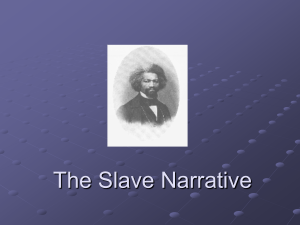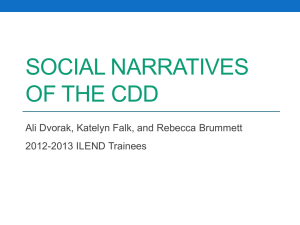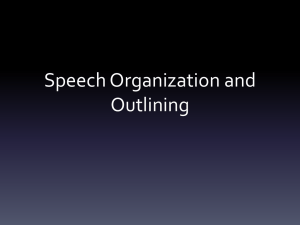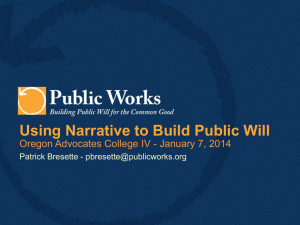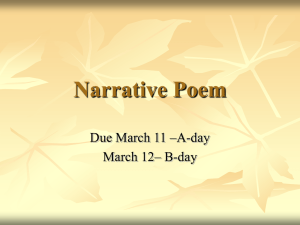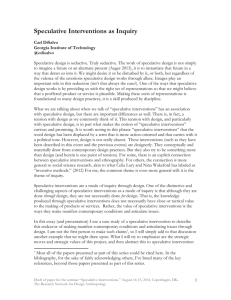SPECULATIVE WRITING - Verona School District
advertisement
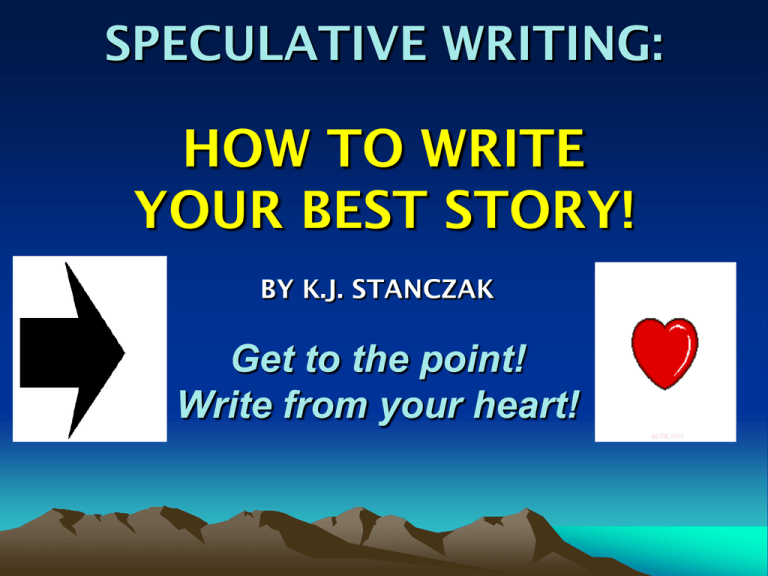
SPECULATIVE WRITING: HOW TO WRITE YOUR BEST STORY! BY K.J. STANCZAK Get to the point! Write from your heart! Speculative Writing - Narratives Playing Make-Believe • Think back to your childhood… Speculative Writing - Narratives Did YOU Know? • SPECULATIVE WRITING is a fancy term for NARRATIVE WRITING. • NARRATIVES are FUN to write • When writing a NARRATIVE, it is best to use your IMAGINATION and BE CREATIVE. • A NARRATIVE tells a STORY and includes ALL story elements. Speculative Writing - Narratives TURN TO SOMEONE NEAR YOU AND ANSWER THE FOLLOWING QUESTION. What are the six elements of a story? DID YOU ANSWER CORRECTLY? Character Setting Plot (including Climax and Resolution) Conflict Theme Point of View Speculative Writing - Narratives Did YOU Know? • NARRATIVE writing can be based on make-believe people, places, events, and situations. • It is important to use dazzling WORD CHOICE when creating your STORY. • A great way to help you with vivid WORD CHOICE is to remember your five senses. •What are your five senses? INCLUDING VIVID and DAZZLING LANGUAGE MEANS TO REMEMBER: •SIMILES •METAPHORS •PERSONIFICATION •ALLITERATION •and ALL OTHER TYPES OF FIGURATIVE LANGUAGE Speculative Writing - Narratives Did YOU Know? • The way you ORGANIZE the NARRATIVE will allow your AUDIENCE to understand and follow along with the story. • NARRATIVE WRITING gives the author POWER to CONNECT with his/her readers. • You will have 30 MINUTES to complete the speculative prompt on the NJASK. Speculative Writing - Narratives The Main Ingredients –CHARACTER 1.MAIN CHARACTER 2.PROTAGONIST (hero or the good guy -- PRO!) 3.ANTAGONIST (the bad guy – ANTI!) 4.SUPPORTING CHARACTERS Speculative Writing - Narratives The Main Ingredients –POINT OF VIEW 1. The point of view is told by the narrator of the story (YOU). 2. The narrator may be a FIRST-PERSON character who tells the story from an “insider” perspective. 3. Another choice is for the narrator to tell the story from an outside perspective called the THIRD-PERSON point of view. Speculative Writing - Narratives The Main Ingredients –SETTING 1.Time and place! It could include: weather conditions, social conditions, historical time period, and/or the mood you create. 2.Create a mental picture for the reader using your five senses. 3.Make the setting come to LIFE using lots of details and strong word choices! Some ideas for setting! Speculative Writing - Narratives The Main Ingredients –PLOT 1.The Story Steps: What happens first, next, after that, then, and last. This is known as the RISING and FALLING ACTION of the story 2.Every story has a problem, situation, or CONFLICT that is clearly introduced early in the story (the opening). 3.The story builds towards (build-up) solving the problem (climax). 4.At the end of the story, the problem is resolved (resolution). A STORY MOUNTAIN Problem Developed Problem intro? Speculative Writing - Narratives The Main Ingredients –ORGANIZATION 1. It is BEST to tell your story in the order or sequence in which the events happen – CHRONOLOGICAL ORDER 2. Try using some of these organizational techniques in your narrative. • Flashback • Foreshadowing • Time lapse Speculative Writing - Narratives The Main Ingredients –THEME 1.The theme is the controlling idea or central insight. 2.It is the author's underlying meaning or main idea being conveyed. 3.The theme may be the author's thoughts about a topic or view of human nature. 4.What is the author’s message(s) in the story? Speculative Writing - Narratives WHAT DO YOU NEED TO DO? TAKE A FEW MINUTES TO GATHER YOUR THOUGHTS. USE THE PROVIDED AREA IN THE NJASK BOOKLET TO BRAINSTORM YOUR IDEAS. REMEMBER CHARACTERS, SETTING, PLOT and THEME. CONSIDER YOUR ENDING FIRST. THIS STRATEGY WILL GIVE YOU SOMETHING TO WORK TOWARDS. INCLUDE A COUPLE OF LINES OF DIALOGUE! WRITE THREE to FIVE PARAGRAPHS. Speculative Writing - Narratives WHAT DO YOU NEED TO DO? • Be sure to INCLUDE: Introduction -- The beginning of the story is where the characters and the setting are explained. Grab reader’s interest quickly. Draw the reader in. Rising Action – The events in the story become complicated and the conflict in the story is revealed. Climactic Moment – The highest point of interest and the turning point of the story are brought to the forefront of the story. The reader wonders what will happen next. Will the conflict be resolved or not? Speculative Writing - Narratives WHAT DO YOU NEED TO DO? • Be sure to INCLUDE: Falling Action – The events and complications begin to resolve themselves. The reader knows what has happened next and if the conflict was resolved or not. Denouement – The final outcome or untangling of events in the story are revealed. Close with a moral or lesson learned. DO YOUR BEST! GOOD LUCK! IMAGES FROM: www.instantdisplay.co.uk www.primaryresources.co.uk http://www.tts-group.co.uk


